Click on images to enlarge
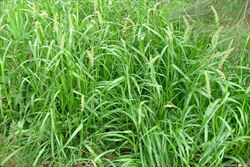
infestation (Photo: Sheldon Navie)

habit (Photo: Sheldon Navie)
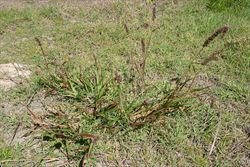
habit (Photo: Sheldon Navie)
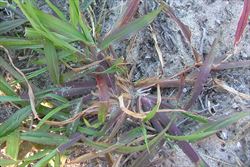
lower leaves and stems (Photo: Sheldon Navie)
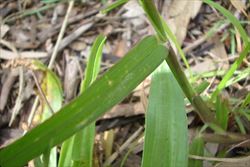
close-up of leaves (Photo: Sheldon Navie)
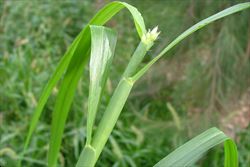
upper leaves and emerging seed-head (Photo: Sheldon Navie)
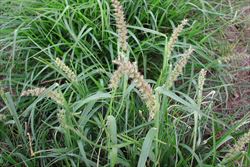
seed-heads (Photo: Sheldon Navie)
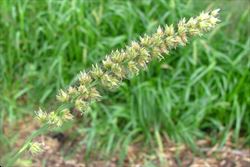
seed-head (Photo: Sheldon Navie)

close-up of a young seed-head in flower (Photo: Sheldon Navie)
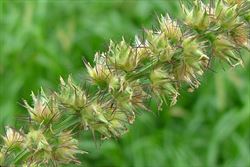
close-up of immature fruit (Photo: Sheldon Navie)
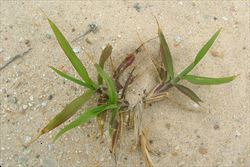
young plant (Photo: Sheldon Navie)
Scientific Name
Cenchrus echinatus L.
Synonyms
Cenchrus brevisetus Fourn.Cenchrus echinatus L. var. hillebrandianus (Hitchc.) R. Br.Cenchrus hillebrandianus Hitchc.Cenchrus insularis Scribn. ex Millsp.Cenchrus macrocarpus hort. ex Steud.Cenchrus pungens KunthCenchrus quinquevalvis Ham. ex Wall.Cenchrus viridis Spreng.
Family
Gramineae (South Australia)Poaceae (Queensland, New South Wales, the ACT, Victoria, Tasmania, Western Australia and the Northern Territory)
Common Names
buffel grass, bur grass, burgrass, burr grass, burr-grass, burrgrass, field sandbur, Galland's curse, hedge-hog grass, hedgehog grass, innocent weed, Mossman burr grass, Mossman burrgrass, Mossman River grass, sand-bur, sandbur, seaforth burr, southern sandbur, southern sandbur grass
Origin
This species is thought to be native to Central America and tropical North America (i.e. Mexico and southern USA), though it is now widespread throughout the tropical regions of the world (i.e. a pan-tropical weed).
Cultivation
This species is not deliberately cultivated in Australia.
Naturalised Distribution
A very widespread species that is naturalised throughout the northern and central parts of Australia (i.e. throughout Queensland and the Northern Territory, in the south-western, western and northern parts of Western Australia, in some parts of northern and eastern New South Wales and in the north-western parts of South Australia). It is most common in the northern parts of Western Australia and in the coastal regions of Queensland. Also naturalised on the Cocos Islands.
Habitat
A weed of tropical, sub-tropical, warmer temperate, semi-arid and arid climates that infests footpaths, urban parks, lawns, roadsides, disturbed sites, waste areas, coastal environs, estuarine areas, grasslands, open woodlands, waterways, wetlands, pastures and crops (e.g. maize, peanuts and cotton).
Habit
A mostly upright (i.e. erect or ascending) and loosely tufted short-lived (i.e. annual) grass, usually growing 25-60 cm tall, but occasionally reaching up to 1 m in height.
Distinguishing Features
- a slightly-tufted, short-lived grass usually growing 25-60 cm tall.
- its stem bases and lower leaf sheaths often have a reddish or purplish-coloured tinge.
- its seed-heads are spike-like with numerous, almost stalkless, burr-like structures (4-10 mm in size).
- these 'burrs' contain several flower spikelets enclosed in numerous spine-tipped bracts and hairy bristles.
- the 'burrs' are reddish or purplish-green when young, but turn straw-coloured or dark brown as they mature.
Stems and Leaves
The stems (i.e. culms) are often branched and have hairless joints (i.e. glabrous nodes). Roots (i.e. adventitious roots) may occasionally be produced at the lowest stem joints (i.e. nodes).
The leaves consist of a sheath, which partially encloses the stem, and a spreading leaf blade. The leaf sheaths are usually hairless (i.e. glabrous), but occasionally have a few hairs, while the leaf blades usually have some hairs present, particularly along their margins. The leaf blades (5-25 cm long and 3-12 mm wide) are very elongated (i.e. linear) and gradually narrow to a pointed tip (i.e. acute apex). Where the leaf sheath meets the leaf blade there is a small structure (i.e. ligule) that consists of a tiny membrane (0.5-2 mm long) topped with a dense line of hairs (i.e. the ligule is a ciliated membrane). The leaf sheaths, especially those on younger plants, and lower stems often have a reddish or purplish-coloured tinge (particularly when growing in a sunny position).
Flowers and Fruit
The seed-head (i.e. inflorescence) is spike-like (i.e. spiciform), but is actually a reduced panicle (3-10 cm long and 1-1.3 cm wide). This seed-head consists of several to many (i.e. 5-50), stalkless (i.e. sessile) or almost stalkless (i.e. sub-sessile), burr-like structures (4-10 mm across), each bearing many sharp rigid spines (2-5 mm long) and also some hairy bristles or flexible spines. These 'burrs' contain a cluster of two to four flower spikelets, and each flower spikelet usually produces a single seed. The flower spikelets (4-7 mm long and 1-2 mm wide) are narrowly egg-shaped in outline (i.e. ovate) with pointed tips (i.e. acuminate apices). They consist of a pair of glumes (i.e. 1.3-5.7 mm long) and a pair of tiny flowers (i.e. florets). The lower floret is usually sterile or occasionally male, while the upper one has both male and female parts (i.e. it is bisexual). Each floret has two bracts (i.e. a palea and a lemma), the male ones have three stamens, and the bisexual ones also have an ovary topped with two feathery stigmas. Flowering occurs mostly during summer and autumn.
The 'burrs' are a reddish or purplish-green colour when young but turn straw-coloured or dark brown as they mature. They detach from the flowering stem entire, and may therefore contain more than one seed. The seeds (i.e. grains or caryopses) are broadly oval (i.e. elliptic) to egg-shaped (i.e. ovoid) and well hidden inside the burrs. These seeds (1.5-3.2 mm long and 1.3-2.2 mm wide) are brown and have a flattened tip (i.e. truncate apex).
Reproduction and Dispersal
This plant reproduces by seed, which are mostly spread when the spiny 'burrs' they are contained within become attached to animals, vehicles and clothing. These 'burrs' may also be dispersed by water and in contaminated agricultural produce (e.g. pasture seeds and wool).
Environmental Impact
Mossman River grass (Cenchrus echinatus) is mainly regarded as an environmental weed in northern Queensland, the Northern Territory, and the northern parts of Western Australia. This species was also recently listed as a priority environmental weed in at least one Natural Resource Management region. It is an aggressive competitor that colonises sandy soils, particularly along the coast, and can have a significant impact on coastal sand dune communities.
For example, Mossman River grass (Cenchrus echinatus) is listed among the top ten environmental weeds in the Kimberley and Pilbara coastal regions of Western Australia. It is also regarded as an environmental weed in the New South Wales north coast region and in south-eastern Queensland, where it appears on the list of the top 200 invasive plants.
Other Impacts
Though this species can provide good grazing when young, is becomes a pest in pastures if it is allowed to mature. The burrs also reduce the value of wool and make shearing hazardous. The spiny burrs also penetrate the hides of livestock causing injury and are also a problem in recreation areas. In addition, Mossman River grass (Cenchrus echinatus) is also an important weed of many summer crops in the tropical and sub-tropical regions of northern Australia.
Legislation
This species is declared under legislation in the following states and territories:
- New South Wales: Class 5 - a restricted weed which must not be sold, bought or knowingly distributed (throughout the entire state).
- Northern Territory: B - growth and spread of this species to be controlled (throughout all of the Territory), and C - not to be introduced into the Territory.
- Western Australia: Prohibited - on the prohibited species list and not permitted entry into the state.
Management
For information on the management of this species see the following resources:
- the Biosecurity Queensland Fact Sheet on this species, which is available online at http://www.dpi.qld.gov.au.
- the Northern Territory Department of Natural Resources, Environment and The Arts Agnote on this species, which is available online at http://www.nt.gov.au/weeds.
Similar Species
Mossman River grass (Cenchrus echinatus) is very similar to the spiny burrgrasses (Cenchrus incertus and Cenchrus longispinus) and Birdwood grass (Cenchrus setigerus). These species can be distinguished by the following differences:
- Mossman River grass (Cenchrus echinatus) has seed-heads that produce
spiny 'burrs'. These 'burrs' are stalkless (i.e. sessile), have one row of
larger flattened spines, and numerous smaller hairy bristles at their base.
These spines are fused at the base (i.e. connate) and are joined together for
some distance (2-5 mm).
- spiny burrgrass (Cenchrus incertus) has seed-heads that produce spiny 'burrs'. These 'burrs' are
almost stalkless (i.e. sub-sessile), have several rows of larger flattened
spines (usually with only 8-25 spines in total), and numerous smaller hairy
bristles at their base. These spines are fused at the base (i.e. connate) and
are joined together for some distance (2-7 mm).
- spiny burrgrass (Cenchrus longispinus) has seed-heads that produce spiny 'burrs'. These 'burrs' are
shortly stalked (i.e. pedicellate), have several rows of larger flattened
spines (usually with 40-70 spines in total), and numerous smaller hairy
bristles at their base. These spines are fused at the base (i.e. connate) and
are joined together for some distance (2-7 mm).
- Birdwood grass (Cenchrus setigerus) has seed-heads that produce somewhat spiny 'burrs'. These 'burrs' have one row of larger flattened spiny bristles, and numerous smaller hairy bristles at their base. The flattened spiny bristles are fused at the base (i.e. connate) and are joined together for a short distance (1-3 mm).
It can also be confused with several other native and introduced species of grasses (i.e. Cenchrus spp. and Pennisetum spp.). To distinguish between all of these, a specialist text should therefore be consulted (e.g. Ausgrass: an interactive key to Australian grasses).

